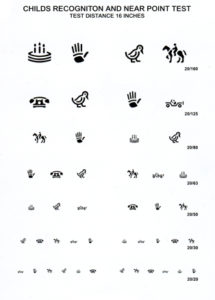August is Children’s Eye Health and Safety Month, which is fitting because this August is the one-year anniversary of my ex-27 week preemie, Theo, getting his glasses.

Parents of preemies are all too familiar with eye exams. Babies born under three pounds or before 30 weeks are screened for Retinopathy of Prematurity (ROP). Preemies are also susceptible to other vision troubles like Amblyopia (lazy eye), Strabismus (crossed eyes), color deficiency (color blindness), and refractive errors (nearsightedness, farsightedness, and astigmatism). W., one of Theo’s NICU neighbors was diagnosed as being nearsighted as a result of ROP. Last year Theo was diagnosed as being farsighted. This had nothing to do with being born 13 weeks early, but was due to my family history of farsightedness.
The American Optometric Association suggests that infants should have their first comprehensive eye exam at six months of age with follow-ups at age three, and then at age five or six. After six, a child’s eyes should be examined every two years unless they have eyeglasses, which normally require an annual examination. Theo’s early intervention clinic caught his vision trouble before we did. A teacher noticed his right eye was crossing. The clinic happened to be offering a free vision screening where we learned that while most toddlers are farsighted, Theo was more farsighted than average. We made a follow up appointment with a pediatric ophthalmologist at his doctor’s office where after a long vision screening and after dilating his eyes, we received the official diagnosis.
Common signs of vision troubles in children include: frequently rubbing eyes, squinting, tilting or turning head to look at objects, wandering eyes, or squeezing eyes. If your child displays any of these symptoms, please schedule an appointment to have their eyes checke d. Nearly one in four kids have vision problems. Undetected vision problems can lead to poor performance in school and affect sports performance.
d. Nearly one in four kids have vision problems. Undetected vision problems can lead to poor performance in school and affect sports performance.
Since his initial diagnosis a year ago, Theo visits the eye doctor for checkups every three months to make sure that his vision is not getting worse or that we don’t need to adjust his prescription. Visits to a children’s eye doctor are very different than what happens when I go for my annual vision check. They tools the ophthalmologist uses look a lot like Happy Meal toys. Theo gets to watch a cartoon of a jumping dog. Because he can’t read yet, his eye chart features shapes, not letters or numbers. In between visits we practice matching the shapes from the eye chart to the worksheet his doctor provided.
Theo’s been in glasses for about a year. Because he’s an active toddler, we purchased two pairs (with a warranty) and have already replaced them once. W., who is also two like Theo, has also gone through two pairs of glasses in eleven months. Our fear was that he’d refuse to wear his glasses. At first he resisted, but as soon as he discovered how much better he could see in them they weren’t an issue. It helps that both his father and I wear glasses, as do many other of our family members and friends. Now the first thing Theo asks when his wakes up is, “Where are my glasses?”
If you are worried about your child’s vision or can’t afford an eye exam there are a number of organizations who offer free exams.

